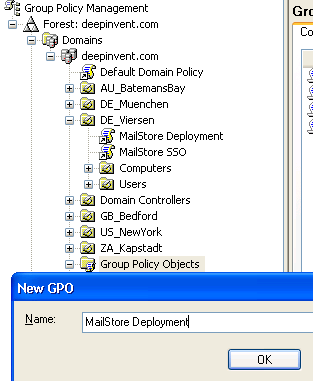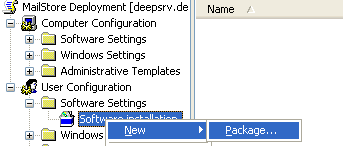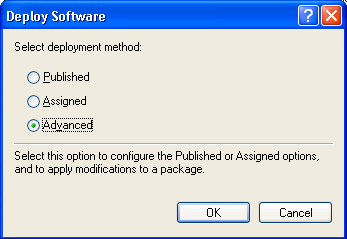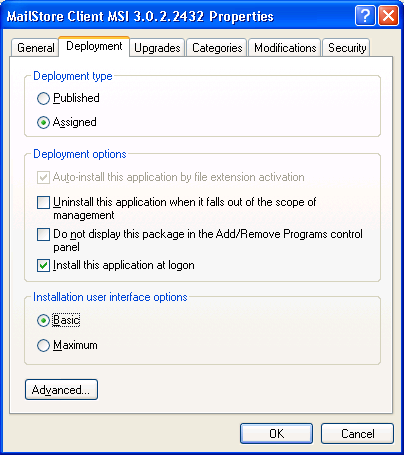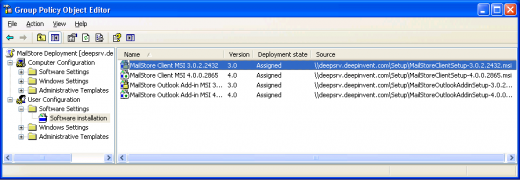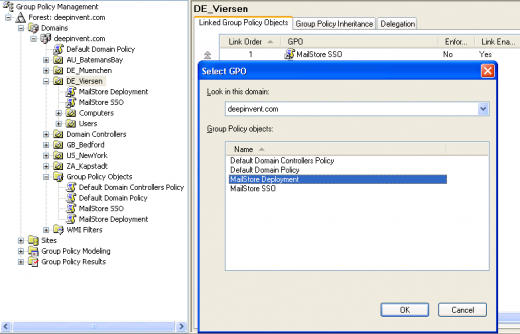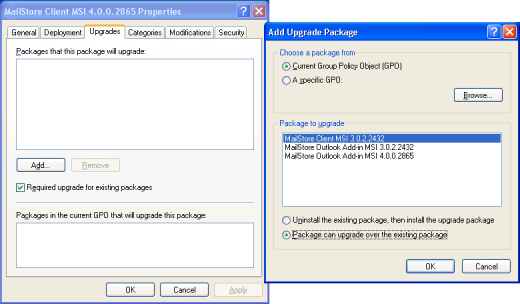MailStore Client Deployment
Using a software distribution system, MailStore Client can be distributed among the users' computers automatically. To be able to do so, the distribution system must be able to execute MailStore Client's setup program without requiring any input or confirmations.
Using Group Policies
Installation
In addition to being installed manually, MailStore Client can also be distributed to all user computers using Active Directory. Once the distribution process is set up successfully, MailStore Client will be installed automatically when the user logs on. This process runs in the background and requires no action on part of the user. Immediately after the distribution, the user can start and use MailStore Client as usual. A shortcut icon on the desktop is created automatically.
Example: Setting up distribution in Windows Server 2003
- Download MailStore Client in .msi format from the MailStore website http://www.mailstore.com/de/mailstore-server-download.aspx
- Save MailStore Client in a directory on the server that is released and accessible to all users of the domain.
- Open the Group Policy Management Console. If this is not available, download the installation routine under http://www.mailstore.com/?gpmc.
- Install the console.
- Open the group policy management console of the Windows server
- Right-click on the administrative folder Group Policy Objects, select New and create a new group policy object called MailStore Deployment.
- Highlight the new object and click on Edit. Expand User Configuration and Software Settings and right-click on Software installation. Select New and Package...
- Select an MSI package. Please keep in mind that the path for the file must be entered in UNC notation (e.g. \\Server\Setup\MailStoreClientsetup...) and that the users of the domain have to have read-access to this directory share.
- In the following dialog window, select Advanced and click OK.
- On the next screen, please select the settings as shown below:
- Click on OK to confirm all settings. The group policy should look similar to the one shown below:
- Close the group policy editor. The group policy is now configured and can be linked to the corresponding user objects. Linking is done using organizational units (OU).
- Highlight the organizational unit (OU) which contains the desired user objects, right-click on the OU (DE_Viersen in the example below) and select the option Link an Existing GPO. In the dialog window Select GPO, highlight MailStore Deployment and click on OK.
- The group policy is now available and becomes active the next time users log on to the Windows client.
Updating
With group policies, the MailStore Client software on the user machines can be updated automatically. This becomes necessary if MailStore Server is updated because the server can only be accessed by clients with the same software version. To edit an existing MailStore deployment group policy so that an automatic update of the clients can be performed, please proceed as follows:
- Open the existing group policy MailStore Deployment. Create a new package and select the updated MailStore Client MSI file. In the following dialog window, select Advanced and click on OK. Please select the settings as shown below:
- In the Updates tab, click on Add and select the software to be updated. Choose the settings as shown below and click on OK and confirm by clicking on OK again.
- The group policy should look similar to the one in the following graphic:
MailStore Client will be updated the next time users log on to their Windows workstations.
To avoid complications when installing software using group policies, the following settings for the MailStore Deployment group policy should be adjusted as well:
- Activate Computer Configuration/Administrative Templates/System/Scripts\Run logon scripts synchronously
- Activate Configuration/Administrative Templates/System/Logon\Always wait for the network at computer startup and logon
Configuration
Installation of Group Policy Template
Configuring MailStore Client
It is possible to set up the hostname or IP-Address of your MailStore Server and whether the MailStore Client should automatically login to your MailStore Server.
- Use Autologon to MailStore Server
- Enables or disables the AutoLogon function
- Server Name:
- In case AutoLogon is enabled, you should also tell the MailStore Client to which server it should connect. The format can either be the hostname or an IP-Address. If MailStore Server is listening on other that the default ports, it is required to add the port information to the hostname or IP-Address in the format :port.
Uninstalling
For Each Installation Distributed Using Group Policies
Just like the distribution, the uninstalling of the software packages can be done using group policies. Please proceed as follows:
- Open the group policy management console of your Windows server.
- Expand the folder Group Policy Objects.
- Right-click on the group policy object which was created for the software distribution of MailStore and select Edit.
- Expand User Configuration | Software Settings | Software Installation
- Right-click on the packet to be uninstalled and select All Tasks -> Delete...
- In the following dialog window, select Software sofort von Benutzern und Computern deinstallieren and click OK.
- Close all open windows and exit the group policy editor.
- The software will be uninstalled the next time the user logs on to the server.
Without using Group Policies
Installation
The silent installation of MailStore Client requires the regular setup program, which can be downloaded from the MailStore website. The request for the silent installation is made to the command line. For example:
MailStoreClientSetup.exe /SP- /SILENT /SUPPRESSMSGBOXES /LOG="log.txt" /NOCANCEL
The command line used in this example will execute a setup which does not require any input or confirmations yet displays the current status of the installation on the screen. To hide the installation progress, simply exchange /SILENT with /VERYSILENT:
MailStoreClientSetup.exe /SP- /VERYSILENT /SUPPRESSMSGBOXES /LOG="log.txt" /NOCANCEL
